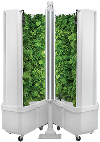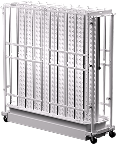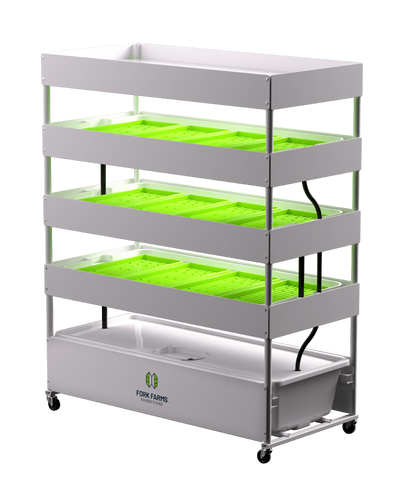How Educators Integrate Hydroponics into K-12 Curriculum
We have officially entered the back-to-school timeframe and we can’t say it enough – the amount of learning opportunities that hydroponic growing systems present is bountiful. From sustainability, environmental awareness, nutrition, and STEM (Science, Technology, Engineering, and Mathematics) education, hydroponic gardening programs in schools offer a multitude of invaluable learning opportunities for students in many areas and across many grade levels.
A hydroponic farm offers hands-on learning opportunities where students can observe, experiment, and actively participate in the growth of plants. Hydroponics is a method of growing plants without soil and is gaining in popularity every day as an effective and sustainable way to grow fresh produce.
With the Flex Farm, an indoor hydroponic farm, students can observe and document the entire life cycle of plants – from germination to harvesting – within a 30-day grow cycle. This efficient growing provides constant hands-on experience and connection to the biological processes and complexities of plant growth. Growing hydroponically enables students to actively participate in real-world farming scenarios, and supports a lifelong appreciation for science and the environment.
Hydroponics in education also nurtures critical thinking skills as students may encounter various challenges throughout the hydroponic growing process. Students who maintain the hydroponic gardens sometimes need to troubleshoot issues such as pH imbalances, nutrient deficiencies, and crop cycles, encouraging them to analyze the problem and find solutions. This approach not only deepens their understanding of STEM concepts, but also inspires creativity, innovation, and collaboration. As students work in their hydroponic gardens, they’ll be cultivating a passion for learning and problem-solving that will surely serve them well in their future endeavors. By taking responsibility for the well-being of the plants, students learn valuable skills, and take on responsibility and ownership – gaining invaluable lifelong skills.
Fork Farms is a leader in the education industry and is committed to growing minds. Currently, more than 1,000 Flex Farms are growing in K-12 schools across the country providing both nutrition and education to students. Each Flex Farm is delivered with a complete K-12 curriculum aligned to Next Generation Science Standards (NGSS), making it desirable for science teachers to add to the syllabus. Teachers and administrators can find everything from learning objectives, extra resources, vocabulary lessons, driving questions, and hands-on activities related to plant biology, nutrition, and sustainable agriculture. There are also proposed assessments at the end of each learning lesson outlined in the comprehensive curriculum. This is a turnkey, plug-and-play curriculum that is easy to follow and built to make an impression.
To learn more firsthand of how some of our partners have used hydroponic gardens in their school’s curriculum, please see this video from the Ashwaubenon School District and this CBS TV segment re: Vincent High School’s Grow Room.
With former educators on staff, the Fork Farms curriculum is designed to be informative, engaging, and memorable. Details on sample lessons follow below for the elementary and intermediate schools, and we have found that many of the high schools we have worked with incorporate STEM learnings into their higher education, AP biology courses, and agribusiness track, and Career and Technical Education (CTE) programs. Concord High School in Michigan recently introduced a new course to their school’s curriculum called Advanced Plant Science which is aligned to state educational science standards and uses Flex Farms for everyday learning. The advanced class is also connected to the food service program, growing lettuces, cilantro, and chives for the school’s salad and taco bars. Check back in on our blog for the full story of what the students are learning and growing at Concord High School soon.
Via the Fork Farms school curriculum plan, educators will find comprehensive lesson plans on topics such as:
The Food We Eat - An overview of farming, where our food comes from, and what plants need to grow. Students will learn about both traditional growing methods and hydroponic growing. They will learn how different plants become different types of food, what kinds of foods can be grown in a Flex Farm, and how the school can be an integral part of the community via the food they can now grow on-site. If the school’s hydroponic garden produces excess produce, students can explore opportunities to make sales at local farmers' markets or donate to local food banks. Students can also research partnership opportunities with local businesses and organizations to further support their growing program.
From Seed to Plant - An overview of the parts of a seed and what each part does to help the seed survive and grow into a plant. Did you know the Flex Farm systems produce highly nutritious leafy greens, herbs, and small fruiting produce that go from harvest to plate within minutes? When a plant is harvested, its nutritional quality begins to decrease. Unfortunately, it is estimated that fresh produce in the United States travels about 1,500 miles to get from farm to plate. Therefore, within the five to 16 days that fresh produce is being transported, nutrient density is lost. Hydroponically-grown vegetables and fruits lose fewer nutrients since the food is grown in the community it is served in, making them among the healthiest fresh foods available.
The PH of water - What pH actually is and how to determine the pH level of a liquid through interactive lab activities. Students will also learn why the pH level of the water is so important for plant growth and how to problem-solve if levels are off.
Growing in the Flex Farm - Students will investigate what a plant needs to grow and learn the process of how plants get their nutrients. Hydroponic plants gain nutrients via nutrient formulas dissolved in water instead of obtaining nutrients from the soil. These special solutions contain essential macronutrients (nitrogen, phosphorus, potassium) and micronutrients (iron, calcium, magnesium, etc.) that are vital for plant growth.
How to Feed 7.8 Billion People – This important lesson explores the world’s food gap and issues with food insecurity. Students are encouraged to explore solutions to reduce the gap, ensure more people have access to fresh food, and find ways to realistically feed 7.8 billion people. Today, two billion people worldwide face food insecurity, and agricultural demand is at a 70 percent increase. There's a systemic issue with the way that fresh food is produced, transported, and distributed within our country and world. Knowing these statistics, it is obvious that change needs to be made and we think growing fresh foods hydroponically is a key part of making positive change.
Plants and the Biology of the Plant Life Cycle - An overview of the parts of a plant, what a plant needs to grow, and the plant life cycle. Through hydroponics, students can explore the biological processes involved in nutrient uptake, photosynthesis, and plant anatomy. Students are given the chance to observe, experiment, and actively participate in the entire life cycle of plants, from germination to harvesting.
What is Harvesting? – How long does it take from seed to harvest for various crops? What are the procedures for safely harvesting the fresh foods grown in your hydroponic garden and then how do you clean, store, and share the fresh food? And, then there is the harvest party where students get to celebrate and enjoy the fruits of their labor. Did you know that on average, lettuce growing outdoors takes 60-72 days from seed to harvest, yet lettuces grown hydroponically in a Flex Farm need 28 days from seed to harvest?
Completing the Life Cycle With Composting – With sustainability at the heart of hydroponic growing, students are introduced to green and brown materials, decomposers, micro and macro organisms, and the benefits of composting.
Sustainability – Students get a crash course on the importance of sustainability in the world today and how we can work to make the world a better place for future generations. Fun facts about the Flex Farm – the annual sustainability impact of utilizing the hydroponic Flex Farms includes the capacity to save 7,300 pounds of food waste, 60,500 food miles, and more than 419,000 gallons of water compared to traditional agricultural practices to produce an equivalent amount of food.
How Our Food is Packaged – Students learn how food is packaged and the intricacies of food labeling. This is an introduction to nutrition and this lesson fosters healthy and mindful eating habits.
We, at Fork Farms, are experts in cultivating learning opportunities, and growing young minds and bodies. To learn how the Flex Farm can be incorporated into your school’s curriculum and the cafeteria as well, please contact one of our team members. A big bounty awaits!
Important Links:
























